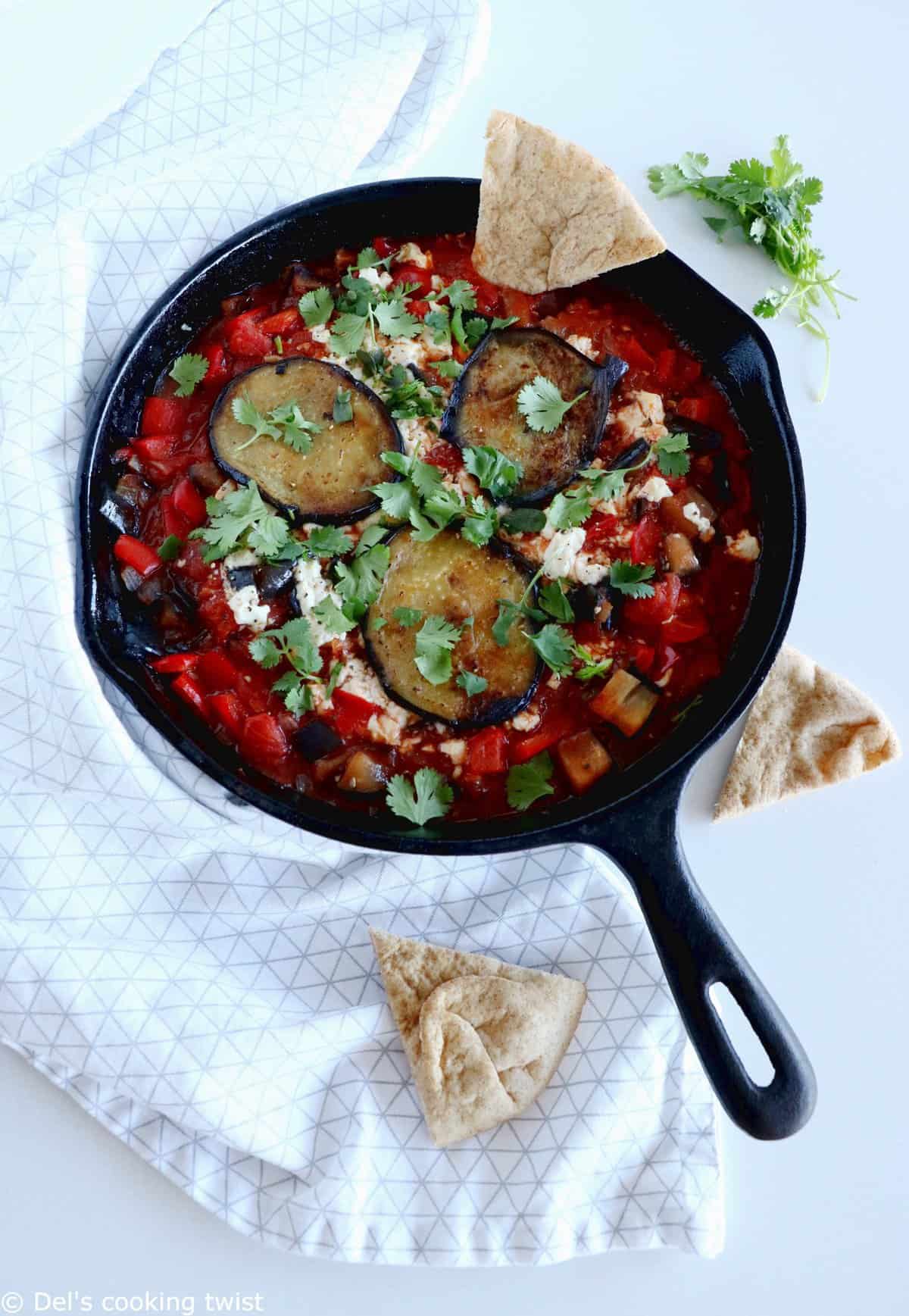
Eggplant Shakshuka: A Taste of the Mediterranean
Indulge in the vibrant flavors of the Mediterranean with our “Eggplant Shakshuka” recipe. This enticing dish, with its tender eggplant, aromatic spices, and savory eggs, will tantalize your taste buds and keep you coming back for more.
Origin and History Of Shakshuka Recipe
Shakshuka, a beloved Middle Eastern and North African breakfast delicacy, has a rich culinary history dating back centuries. Its origins are believed to have emerged in the 16th century Maghreb region, with influences from Ottoman, Jewish, and Berber cuisines.
Initially, shakshuka was often cooked in a communal tagine or skillet, with each person dipping bread into the egg and vegetable mixture. Over time, it became a popular dish in homes across the region, each family adapting it with their unique blend of spices.
Personal Touch
My first encounter with shakshuka was during a memorable trip to Marrakech, Morocco. The vibrant souks, with their aromatic spice stalls, gave me a glimpse into the culinary opulence of the region. I was fortunate enough to taste this delectable dish at a local riad, where it was served with freshly baked bread. The flavors and textures left an unforgettable impression on me.
Tings To Expect In This Post Article
In this post, we will embark on a culinary journey, exploring the ingredients, preparation steps, and nutritional benefits of this Mediterranean masterpiece. Join us as we uncover the secrets of creating a mouthwatering shakshuka dish in the comfort of your own kitchen.
Ingredients List
- 1 large eggplant, cut into 1-inch cubes
- 3 tablespoons olive oil
- 1 large onion, chopped
- 3 cloves garlic, pressed
- 400g crushed tomatoes
- 1 teaspoon smoked paprika
- 1 teaspoon ground coriander
- 1 teaspoon ground cumin
- 1/2 teaspoon turmeric
- 1/4 teaspoon salt
- 1/4 teaspoon black pepper
- 4 large eggs
Preparation Steps
- Heat olive oil in a large saucepan over medium heat. Add the eggplant cubes and cook until lightly browned and softened, approximately 5-7 minutes.
- Add the onion and garlic to the pan and sauté for 3-4 minutes, until softened.
- Stir in the crushed tomatoes, smoked paprika, ground coriander, ground cumin, turmeric, salt, and black pepper. Bring to a simmer and cook for 15 minutes, or until the tomatoes have thickened.
- Create four small wells in the sauce and crack an egg into each well. Season lightly with salt and pepper.
- Cover the pan and simmer for 10-12 minutes, or until the eggs are cooked to your desired doneness.
Cooking Time & Servings
Total cooking time: Approximately 30-35 minutes
Number of servings: 4
Nutritional Information
Per serving:
- Calories: 340
- Protein: 15g
- Carbohydrates: 35g
- Fat: 20g
- Fiber: 5g
- Vitamin C: 50mg
- Potassium: 400mg
Health Conditions And People To Avoid This
For individuals with certain health conditions, it is important to note the potential limitations of this recipe:
- Allergies: Eggplant and eggs are common allergens. If you have allergies to either, it is best to avoid consuming this dish.
- Kidney Disease: Individuals with kidney disease should consult their healthcare provider before eating eggplant, as it contains a moderate amount of potassium.
- Low-Oxalate Diet: Eggplant is a high-oxalate vegetable. If you are following a low-oxalate diet for kidney or other health reasons, it is recommended to limit or avoid consuming eggplant.
- Digestive Issues: Eating excessive amounts of shakshuka may cause digestive discomfort or bloating, especially for those with sensitive stomachs.
Nutrition and Benefits To The Body
This recipe offers a rich array of nutrients, including:
- Vitamin C: Essential for immune function, collagen production, and antioxidant protection.
- Potassium: Regulates blood pressure, promotes electrolyte balance, and supports muscle function.
- Fiber: Aids in digestion, maintains regular bowel movements, and helps control blood sugar levels.
Disadvantages
While these nutrients are beneficial for health, excessive consumption can lead to certain adverse effects:
- Vitamin C (in very high doses): May cause nausea, vomiting, or diarrhea. Eating moderately is perfectly fine, but acquiring excess of this nutrients is harmful.
- Potassium (in excess): Can lead to high potassium levels in the blood (hyperkalemia), which can be dangerous for individuals with kidney problems. Eating moderately is perfectly fine, but acquiring excess of this nutrients is harmful.
- Fiber (in very high doses): May cause gas, bloating, or constipation. Eating moderately is perfectly fine, but acquiring excess of this nutrients is harmful.
Tips and Tricks
- For a spicier shakshuka, add a pinch of cayenne pepper or chili flakes to the sauce.
- To add extra depth of flavor, use canned diced tomatoes with green chilies.
- If your eggplant is bitter, sprinkle some salt on the cubes and let them rest for 30 minutes before cooking. This will draw out the bitter juices.
- For a vegetarian version, replace the eggs with crumbled tofu or chickpeas.
- Serve your shakshuka with crusty bread, pita, or naan to soak up all the delicious sauce.
Equipment Needed
- Large saucepan
- Spatula or spoon
- Cutting board
- Knife
Variations or Substitutions
- If you don’t have eggplant, you can substitute it with zucchini, bell peppers, or potatoes.
- For a dairy-free version, replace the eggs with a plant-based alternative such as tofu scramble.
- To make your shakshuka extra special, add crumbled feta cheese or chopped olives before serving.
Serving Suggestions
- Serve shakshuka with a side of fresh herbs such as parsley, cilantro, or mint.
- Create a colorful and fragrant garnish using chopped tomatoes, onions, and peppers.
- For a more substantial meal, pair your shakshuka with grilled halloumi cheese or falafel.
Storage and Reheating Instructions
- Leftover shakshuka can be stored in an airtight container in the refrigerator for up to 3 days.
- To reheat, transfer the desired portion to a saucepan and heat over medium heat until warmed through.
Conclusion
Embark on a culinary adventure with our delectable “Eggplant Shakshuka” recipe. Its vibrant flavors and nutritional value make it a dish that will tantalize your palate and nourish your body. Gather your loved ones, share this culinary masterpiece, and create memories that will last a lifetime.
If you have enjoyed this recipe and found it helpful, please share your creations with us on social media using the hashtag #EggplantShakshukaRecipe. We would love to see your photos and hear about your experiences.
Don’t hesitate to ask questions or share your own cooking tips. We are always here to connect and engage with our passionate culinary community.
Frequently Asked Question (FAQs)
Can I use other vegetables instead of eggplant?
Yes, you can substitute eggplant with zucchini, bell peppers, or potatoes for a different flavor and texture.
How can I make a vegetarian shakshuka?
Replace the eggs with crumbled tofu or chickpeas for a delicious vegetarian version.
Can I add other ingredients to my shakshuka?
Absolutely! Feel free to add crumbled feta cheese, chopped olives, or even grilled halloumi cheese for extra flavor and texture.
How should I store any leftover shakshuka?
Transfer leftovers to an airtight container and store them in the refrigerator for up to 3 days.
Is this recipe suitable for people with gluten or dairy allergies?
Yes, this recipe is naturally gluten-free and dairy-free. Ensure that the ingredients you use, such as bread or cheese, are also gluten-free or dairy-free if needed.


















Leave a Reply